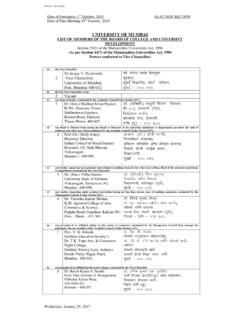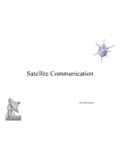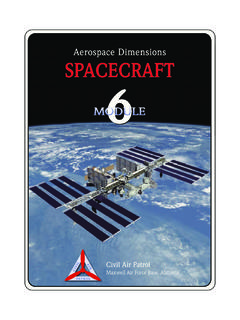Transcription of SATELLITE COMMUNICATION AN INTRODUCTION
1 1 SATELLITE COMMUNICATION AN INTRODUCTION Contents INTRODUCTION Basics Applications of Satellites o Weather Forecasting o Radio and TV Broadcast o Military o Navigation o Global Telephone o Connecting Remote Areas o Global Mobile COMMUNICATION Frequency Allocation of Satellites Types of Orbits o GEO o LEO o MEO o Sun Synchronous Orbit o Hohmann Transfer Orbit o Prograde Orbit o Retrograde Orbit o Polar Orbits Examples o INTELSAT o Domsats o Polar Orbiting Satellites Summary Exercise INTRODUCTION Satellites are specifically made for telecommunication purpose. They are used for mobile applications such as COMMUNICATION to ships, vehicles, planes, hand-held terminals and for TV and radio broadcasting. 2 They are responsible for providing these services to an assigned region (area) on the earth .
2 The power and bandwidth of these satellites depend upon the preferred size of the footprint, complexity of the traffic control protocol schemes and the cost of ground stations. A SATELLITE works most efficiently when the transmissions are focused with a desired area. When the area is focused, then the emissions don t go outside that designated area and thus minimizing the interference to the other systems. This leads more efficient spectrum usage. SATELLITE s antenna patterns play an important role and must be designed to best cover the designated geographical area (which is generally irregular in shape). Satellites should be designed by keeping in mind its usability for short and long term effects throughout its life time. The earth station should be in a position to control the SATELLITE if it drifts from its orbit it is subjected to any kind of drag from the external forces.
3 BASICS Satellites orbit around the earth . Depending on the application, these orbits can be circular or elliptical. Satellites in circular orbits always keep the same distance to the earth s surface following a simple law: The attractive force Fg of the earth due to gravity equals m g (R/r) 2 The centrifugal force Fc trying to pull the SATELLITE away equals m r 2 The variables have the following meaning: m is the mass of the SATELLITE ; R is the radius of earth with R = 6,370 km; ri s the distance of the SATELLITE to the centre of the earth ; g is the acceleration of gravity with g = m/s2; is the angular velocity with = 2 f, f is the frequency of the rotation. To keep the SATELLITE in a stable circular orbit, the following equation must hold: Fg = Fc, , both forces must be equal.
4 Looking at this equation the first thing to notice is that the mass m of a SATELLITE is irrelevant (it appears on both sides of the equation). Solving the equation for the distance r of the SATELLITE to the centre of the earth results in the following equation: 3 The distance r = (g R2/(2 f)2)1/3 From the above equation it can be concluded that the distance of a SATELLITE to the earth s surface depends on its rotation frequency. Important parameters in SATELLITE COMMUNICATION are the inclination and elevation angles. The inclination angle (figure ) is defined between the equatorial plane and the plane described by the SATELLITE orbit. An inclination angle of 0 degrees means that the SATELLITE is exactly above the equator. If the SATELLITE does not have a circular orbit, the closest point to the earth is called the perigee.
5 Figure : Angle of Inclination The elevation angle (figure ) is defined between the centre of the SATELLITE beam and the plane tangential to the earth s surface. A so called footprint can be defined as the area on earth where the signals of the SATELLITE can be received. Figure : Angle of Elevation APPLICATIONS OF SATELLITES ) Weather Forecasting Certain satellites are specifically designed to monitor the climatic conditions of earth . They continuously monitor the assigned areas of earth and predict the weather conditions of that region. This is done by taking images of earth from the SATELLITE . These images are transferred using assigned radio frequency to the earth station. ( earth Station: it s a radio station located on the earth and used for relaying signals from satellites.
6 These satellites are exceptionally useful in predicting disasters like hurricanes, and 4 monitor the changes in the earth 's vegetation, sea state, ocean color, and ice fields. ) Radio and TV Broadcast These dedicated satellites are responsible for making 100s of channels across the globe available for everyone. They are also responsible for broadcasting live matches, news, world-wide radio services. These satellites require a 30-40 cm sized dish to make these channels available globally. ) Military Satellites These satellites are often used for gathering intelligence, as a communications SATELLITE used for military purposes, or as a military weapon. A SATELLITE by itself is neither military nor civil. It is the kind of payload it carries that enables one to arrive at a decision regarding its military or civilian character.
7 Navigation Satellites The system allows for precise localization world-wide, and with some additional techniques, the precision is in the range of some meters. Ships and aircraft rely on GPS as an addition to traditional navigation systems. Many vehicles come with installed GPS receivers. This system is also used, , for fleet management of trucks or for vehicle localization in case of theft. ) Global Telephone One of the first applications of satellites for COMMUNICATION was the establishment of international telephone backbones. Instead of using cables it was sometimes faster to launch a new SATELLITE . But, fiber optic cables are still replacing SATELLITE COMMUNICATION across long distance as in fiber optic cable, light is used instead of radio frequency, hence making the COMMUNICATION much faster (and of course, reducing the delay caused due to the amount of distance a signal needs to travel before reaching the destination.
8 Using satellites, to typically reach a distance approximately 10,000 kms away, the signal needs to travel almost 72,000 kms, that is, sending data from ground to SATELLITE and (mostly) from SATELLITE to another location on earth . This cause s substantial amount of delay and this delay becomes more prominent for users during voice calls. ) Connecting Remote Areas Due to their geographical location many places all over the world do not have direct wired connection to the telephone network or the internet ( , researchers on Antarctica) or because of the current state of the infrastructure of a country. Here the SATELLITE 5 provides a complete coverage and (generally) there is one SATELLITE always present across a horizon. ) Global Mobile COMMUNICATION The basic purpose of satellites for mobile COMMUNICATION is to extend the area of coverage.
9 Cellular phone systems, such as AMPS and GSM (and their successors) do not cover all parts of a country. Areas that are not covered usually have low population where it is too expensive to install a base station. With the integration of SATELLITE COMMUNICATION , however, the mobile phone can switch to satellites offering world-wide connectivity to a customer. Satellites cover a certain area on the earth . This area is termed as a footprint of that SATELLITE . Within the footprint, COMMUNICATION with that SATELLITE is possible for mobile users. These users communicate using a Mobile-User-Link (MUL). The base-stations communicate with satellites using a Gateway-Link (GWL). Sometimes it becomes necessary for SATELLITE to create a COMMUNICATION link between users belonging to two different footprints.
10 Here the satellites send signals to each other and this is done using Inter- SATELLITE -Link (ISL). FREQUENCY ALLOCATION FOR SATELLITE Allocation of frequencies to SATELLITE services s a complicated process which requires international coordination and planning. This is done as per the International Telecommunication Union (ITU). To implement this frequency planning, the world is divided into three regions: Region1: Europe, Africa and Mongolia Region 2: North and South America and Greenland Region 3: Asia (excluding region 1 areas), Australia and south-west Pacific. Within these regions, he frequency bands are allocated to various SATELLITE services. Some of them are listed below. Fixed SATELLITE service: Provides Links for existing Telephone Networks Used for transmitting television signals to cable companies Broadcasting SATELLITE service: Provides Direct Broadcast to homes.












